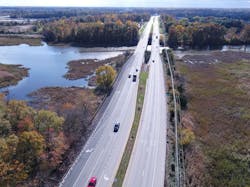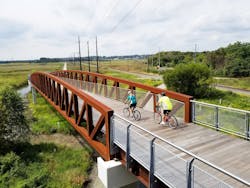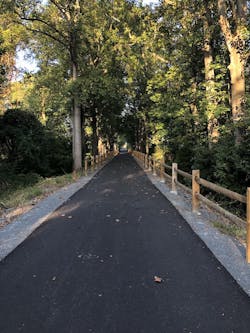Network of multimodal trails connects communities in Delaware
By: C.R. McLeod and Kathryn Beasley
Departments of Transportation are tasked with solving transportation issues before they come to fruition. This includes evaluating continuously evolving transportation networks and utilizing that data to develop new and cost-effective solutions to build safer roadways capable of handling great commuter capacities years and decades into the future.
This process of predicting changes in land use, demographics, travel patterns, preferences, and technology is not just reserved for routes accessed by motorized vehicles, but those accessed by pedestrians and bicyclists as well.
For the Delaware Department of Transportation, the goal to build a better multimodal transportation network began over 20 years ago. Fueled by a growing interest in alternative modes of transportation and a continued focus on the impact of greenhouse gases on the climate, the department created a blueprint for what will eventually become a network of trails connecting communities in all three counties and across the entire state.
These are trails that Delawareans could utilize for both recreation and as an alternate mode of transportation. The trails will wander through some of the most beautiful scenery in the state while providing direct routes to places of employment, government buildings, community centers, transit centers, popular destinations, restaurants, and other points of interest. They will also provide safe routes to schools and beloved destinations, and will help reduce the number of motorized vehicles on Delaware’s roadways.
Over the past two decades, DelDOT has significantly invested in its trail system to support and encourage alternatives to motor vehicle travel. Collectively—with the help of two governors, multiple agencies including the Department of Natural Resources and Environmental Control, working groups, stakeholders, and 35 municipalities—several key pieces are nearly complete. Each milestone brings the department closer to achieving its vision of providing a low-stress, interconnected trail system that meets the increased interest and desire of residents and visitors that prefer walking and biking over motorized forms of transportation.
The department celebrated the completion of Phase 1 of what will become the largest trail in Kent County, Delaware in 2016. The Capital City Trail will span 15 miles once finished and will provide a safe path of travel through the City of Dover and neighboring Towns of Camden and Wyoming. Residents traveling the trail will pass numerous retail establishments, restaurants, various downtown businesses, a library, numerous bus stops, schools, a transportation center, the DMV, and several parks, before reaching Legislative Hall at one end and Dover Air Force Base housing near the other. Phase II of the trail was completed in July of 2021, and Phase III will begin this spring.
Challenges for the Capital City Trail:
- Minor, as most of the project was built within the state’s right-of-way (ROW)
- The remaining ROW needed was acquired through donations
- Some of the trail already existed and just required reclaiming and resurfacing
Uniqueness:
- Approximately 40% of the trail is maintained by an adjacent municipality
- Early phases of the project utilized stimulus funding
- The high number of community connections the trail provides
Cost: Once complete, approximately $7.2 million
Two years later, Gov. John Carney paid tribute to his predecessor who shared his vision of a statewide network of pathways and trails at a ceremony marking the completion of a 7.9-mile trail in New Castle County. The Jack A. Markell Trail connects the City of Wilmington with Old New Castle, providing direct access to multiple downtown businesses, attractions, and restaurants while connecting two of the largest population areas in New Castle County.
Before reaching their destination, users wander over marshes and wetlands via an elevated boardwalk and cross the Christina River on a bridge created solely for pedestrian and bicycle traffic. Much like the Capital City Trail, it was paramount that the trail served as an alternate mode of transportation and provided a safe route to numerous downtown employers, neighborhoods, schools, professional services, and everything else in between.
Challenges for Jack A. Markell Trail:
- Most of the project was built on or through marshlands
- Protecting environmentally sensitive wetlands was paramount
- Limited access required use of barges throughout construction
- The exact location of a 72-in. underground sewer main that runs adjacent to the trail was not able to be determined. It was in poor shape, and if it ruptured there was no way to shut it down. The line was constantly monitored during all phases of construction.
Uniqueness:
- The trail travels through one of the most serene and nature rich areas in the state while providing a high level of connectivity
- Completely maintained by New Castle County
- Portions of the trail created from decommissioned railway
- Utilized two underpasses previously built by the Delaware River and Bay Authority to provide safe crossing under I-95 and I-295
- Early phases used stimulus funding to design and construct
Cost: Approximately $24 million
Another reason to celebrate came a month later—a vision of a trail that transformed a decommissioned railway into one of the most popular trails in the state became a reality. Phase 1 of the Georgetown to Lewes Trail opened in October of 2018. Once complete, the trail will span over 17 miles and connect Georgetown—the heart of Sussex County—to the quaint historic town of Lewes.
During the summer months, traffic volumes increase significantly as they do in most beach communities. Residents and tourists eager to relax oceanside suddenly find themselves in long queues on Route 1, the most direct route from northern to southern Delaware. Those interested in taking a more scenic route can leave their cars behind and walk or bike to Cape Henlopen State Park, local restaurants, local businesses, and multiple retail establishments.
Those looking for even more options can take the Georgetown to Lewes Trail to the Junction and Breakwater Pathway and visit the neighboring city of Rehoboth Beach thanks to a trail extension that was completed in May of 2021, which provides a safe, 14-mile loop between Lewes and Rehoboth Beach.
Not only do both trails wander through some of the most beautiful areas in Sussex County, but they also help reduce capacity on Route 1 and surrounding roadways from May to September. Less time sitting in traffic means more time to explore, shop, dine, and experience these truly unique destinations. Phase 8 of the Georgetown to Lewes Trail was completed in October of 2021. Construction on the next segment from Cool Spring Road to Fisher Road is scheduled to start in April 2022 and will be completed in August 2022. This segment includes a connection to the proposed Hudson Park along U.S. 9.
Challenges for the Georgetown to Lewes Trail:
- Some adjacent property owners through the years had encroached into the railroad right-of-way which will be utilized for trail construction of the Georgetown to Lewes Trail
- Maintaining safety of trail users at numerous trail/road crossings
- Trail attracts bicyclists of all skill levels; environment needed to be safe for those traveling at a fast pace and those traveling at a slower pace
- Trail will be heavily used by both pedestrians and cyclists
Uniqueness:
- Connects a series of trails and pathways in a highly populated beach community, allowing users to move freely by foot or by bicycle between neighborhoods, popular attractions, and adjacent towns
- Business owners along the trail embraced the cycling community, adding amenities to accommodate users
- Local bicycle groups assist with trail maintenance
- Portions of the trail created from decommissioned railway
Cost: Estimated cost once all phases are complete is $31 million
The state of Delaware has more than 500 miles of pedestrian and bike trails that allow users to travel through historical towns, experience the beautiful outdoor spaces, and appreciate all that makes the state so unique. Today, DelDOT’s vision remains as it did two decades ago: To build a system of trails that will give residents and tourists front-door access to a bicycle network that is safe, comfortable, and conveniently connected to places they want to go.
For more information, trail maps, or details on upcoming projects, visit DelDOT.gov.
About The Author: McLeod is director of community relations for DelDOT. Beasley is a community relations officer for DelDOT.





